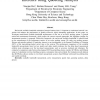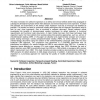248 search results - page 42 / 50 » A Unifying Model of Variables and Names |
HLPPP
1991
13 years 11 months ago
1991
Swarm is a computational model which extends the UNITY model in three important ways: (1) UNITY’s fixed set of variables is replaced by an unbounded set of tuples which are add...
BIOINFORMATICS
2006
13 years 7 months ago
2006
Motivation: Most previous approaches to model biochemical networks havefocusedeither on the characterization of a networkstructurewith a number of components or on the estimation ...
CN
2006
13 years 7 months ago
2006
End-to-end available bandwidth estimation between Internet hosts is important to understand network congestion and enhance the performance of Quality-of-Service (QoS) demanding ap...
ADHOC
2005
13 years 7 months ago
2005
While sensor networks are going to be deployed in diverse application specific contexts, one unifying view is to treat them essentially as distributed databases. The simplest mech...
JSS
2000
13 years 7 months ago
2000
The basic motivation for software inspections is to detect and remove defects before they propagate to subsequent development phases where their detection and removal becomes more...


